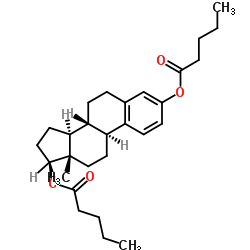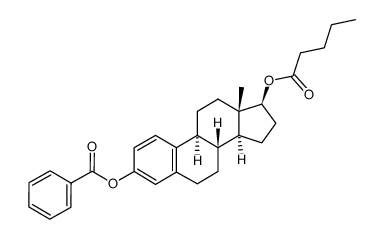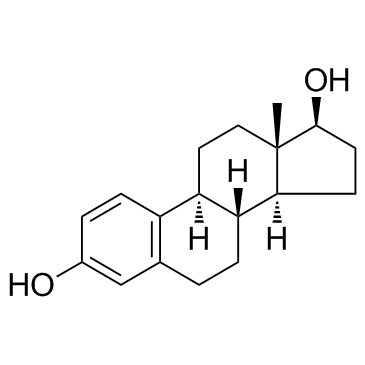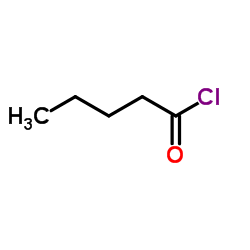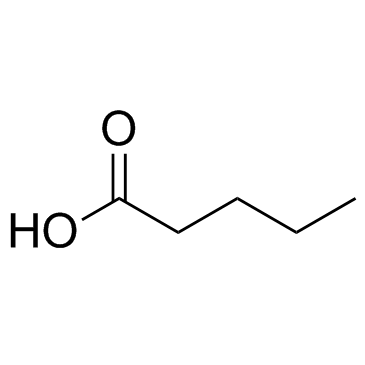Estradiol valerate

Estradiol valerate structure
|
Common Name | Estradiol valerate | ||
|---|---|---|---|---|
| CAS Number | 979-32-8 | Molecular Weight | 356.498 | |
| Density | 1.1±0.1 g/cm3 | Boiling Point | 486.2±45.0 °C at 760 mmHg | |
| Molecular Formula | C23H32O3 | Melting Point | 144°C | |
| MSDS | Chinese USA | Flash Point | 191.1±21.5 °C | |
| Symbol |

GHS08 |
Signal Word | Danger | |
Use of Estradiol valerateEstradiol valerianate (β-estradiol 17-valerate) is a synthetic estrogen widely used in combination with other steroid hormones in hormone replacement therapy drugs. |
| Name | Estradiol 17-Valerate |
|---|---|
| Synonym | More Synonyms |
| Description | Estradiol valerianate (β-estradiol 17-valerate) is a synthetic estrogen widely used in combination with other steroid hormones in hormone replacement therapy drugs. |
|---|---|
| Related Catalog | |
| Target |
Estrogen Receptor/ERR |
| In Vitro | β-estradiol 17-valerate (EV) is a synthetic estrogen widely used in combination with other steroid hormones in hormone replacement therapy drugs and is detected in natural waters. EV is a reproductive toxicant and estrogenic chemical in both male and female fish [1]. |
| References |
| Density | 1.1±0.1 g/cm3 |
|---|---|
| Boiling Point | 486.2±45.0 °C at 760 mmHg |
| Melting Point | 144°C |
| Molecular Formula | C23H32O3 |
| Molecular Weight | 356.498 |
| Flash Point | 191.1±21.5 °C |
| Exact Mass | 356.235138 |
| PSA | 46.53000 |
| LogP | 6.62 |
| Vapour Pressure | 0.0±1.3 mmHg at 25°C |
| Index of Refraction | 1.568 |
|
β-Estradiol 17-Valerate
SAFETY DATA SHEET Section1. IDENTIFICATION Product name:β-Estradiol 17-Valerate Section2. HAZARDS IDENTIFICATION GHS classification
PHYSICAL HAZARDSNot classified
HEALTH HAZARDS CarcinogenicityCategory 2 Reproductive toxicityCategory 1B ENVIRONMENTAL HAZARDSNot classified GHS label elements, including precautionary statements Pictograms or hazard symbols Signal wordDanger Hazard statementsSuspected of causing cancer May damage fertility or the unborn child Precautionary statements: [Prevention]Obtain special instructions before use. Do not handle until all safety precautions have been read and understood. Use personal protective equipment as required. [Response]IF exposed or concerned: Get medical advice/attention. [Storage]Store locked up. [Disposal]Dispose of contents/container through a waste management company authorized by the local government. Section3. COMPOSITION/INFORMATION ON INGREDIENTS Substance Substance/mixture: Components:β-Estradiol 17-Valerate Percent:>98.0%(GC) CAS Number:979-32-8 Chemical Formula:C23H32O3 Section4. FIRST AID MEASURES Remove victim to fresh air and keep at rest in a position comfortable for breathing. Inhalation: Get medical advice/attention. Remove/Take off immediately all contaminated clothing. Gently wash with plenty of Skin contact: soap and water. Get medical advice/attention. β-Estradiol 17-Valerate Section4. FIRST AID MEASURES Rinse cautiously with water for several minutes. Remove contact lenses, if present Eye contact: and easy to do. Get medical advice/attention. Get medical advice/attention.Rinse mouth. Ingestion: Protection of first-aiders:A rescuer should wear personal protective equipment, such as rubber gloves and air- tight goggles. Section5. FIRE-FIGHTING MEASURES Dry chemical, foam, water spray, carbon dioxide. Suitable extinguishing media: Precautions for firefighters: Fire-extinguishing work is done from the windward and the suitable fire-extinguishing method according to the surrounding situation is used. Uninvolved persons should evacuate to a safe place. In case of fire in the surroundings: Remove movable containers if safe to do so. When extinguishing fire, be sure to wear personal protective equipment. Special protective equipment for firefighters: Section6. ACCIDENTAL RELEASE MEASURES Personal precautions,Use extra personal protective equipment (P3 filter respirator for toxic particles). Keep protective equipment and people away from and upwind of spill/leak. Entry to non-involved personnel should emergency procedures: be controlled around the leakage area by roping off, etc. Environmental precautions: Prevent product from entering drains. Methods and materials for Sweep dust to collect it into an airtight container, taking care not to disperse it. containment and cleaning Adhered or collected material should be promptly disposed of, in accordance with up: appropriate laws and regulations. Section7. HANDLING AND STORAGE Precautions for safe handling Technical measures:Handling is performed in a well ventilated place. Wear suitable protective equipment. Prevent dispersion of dust. Wash hands and face thoroughly after handling. Use a closed system if possible. Use a local exhaust if dust or aerosol will be generated. Advice on safe handling:Avoid all contact! Conditions for safe storage, including any incompatibilities Keep container tightly closed. Store in a cool and dark place. Storage conditions: Store locked up. Store away from incompatible materials such as oxidizing agents. Packaging material:Comply with laws. Section8. EXPOSURE CONTROLS / PERSONAL PROTECTION Engineering controls:Install a closed system or local exhaust. Also install safety shower and eye bath. Personal protective equipment Respiratory protection: Dust respirator, self-contained breathing apparatus(SCBA), supplied air respirator, etc. Use respirators approved under appropriate government standards and follow local and national regulations. Hand protection:Impervious gloves. Eye protection:Safety goggles. A face-shield, if the situation requires. Skin and body protection: Impervious protective clothing. Protective boots, if the situation requires. Section9. PHYSICAL AND CHEMICAL PROPERTIES Physical state (20°C):Solid Form:Crystal- Powder Colour:White - Very pale yellow Odour:Odorless pH: No data available Melting point/freezing point:148°C β-Estradiol 17-Valerate Section9. PHYSICAL AND CHEMICAL PROPERTIES No data available Boiling point/range: Flash point:No data available Flammability or explosive limits: No data available Lower: Upper:No data available No data available Relative density: Solubility(ies): Insoluble (3.6mg/L, 27°C) [Water] [Other solvents] Ether, Ethanol, Dioxane Very soluble: Soluble:Methanol, Chloroform Section10. STABILITY AND REACTIVITY Chemical stability:Stable under proper conditions. Possibility of hazardous No special reactivity has been reported. reactions: Incompatible materials: Oxidizing agents Hazardous decomposition Carbon monoxide, Carbon dioxide products: Section11. TOXICOLOGICAL INFORMATION Acute Toxicity:No data available Skin corrosion/irritation: No data available Serious eyeNo data available damage/irritation: Germ cell mutagenicity: No data available scu-mus TDLo:400 ug/kg/1W-I Carcinogenicity: scu-rat TDLo:104 mg/kg/2Y-I IARC =No data available NTP =No data available Reproductive toxicity:No data available RTECS Number:KG5793000 Section12. ECOLOGICAL INFORMATION Ecotoxicity: No data available Fish: Crustacea:No data available No data available Algae: Persistence / degradability: No data available No data available Bioaccumulative potential(BCF): Mobility in soil Log Pow:No data available No data available Soil adsorption (Koc): Henry's LawNo data available constant(PaM3/mol): Section13. DISPOSAL CONSIDERATIONS Recycle to process, if possible. Consult your local regional authorities. You may be able to dissolve or mix material with a combustible solvent and burn in a chemical incinerator equipped with an afterburner and scrubber system. Observe all federal, state and local regulations when disposing of the substance. Section14. TRANSPORT INFORMATION Hazards Class:Does not correspond to the classification standard of the United Nations Not listed UN-No: β-Estradiol 17-Valerate Section15. REGULATORY INFORMATION Safe management ordinance of dangerous chemical product (State Council announces on January 26, 2002 and revised on February 16,2011): Safe use and production, the storage of a dangerous chemical, transport, loading and unloading were prescribed. SECTION 16 - ADDITIONAL INFORMATION N/A |
CHEMICAL IDENTIFICATION
HEALTH HAZARD DATAACUTE TOXICITY DATA
|
| Symbol |

GHS08 |
|---|---|
| Signal Word | Danger |
| Hazard Statements | H360 |
| Precautionary Statements | P201-P280-P308 + P313 |
| Personal Protective Equipment | Eyeshields;full-face particle respirator type N100 (US);Gloves;respirator cartridge type N100 (US);type P1 (EN143) respirator filter;type P3 (EN 143) respirator cartridges |
| Hazard Codes | T:Toxic |
| Risk Phrases | R60;R61 |
| Safety Phrases | S53-S45 |
| RIDADR | 2811.0 |
| WGK Germany | 3 |
| RTECS | KG5793000 |
|
~73% 
Estradiol valerate CAS#:979-32-8 |
| Literature: LUPIN LIMITED; Sasane, Sachin Arun; Ahire, Vijay Ashok; Vyas, Rajesh; Bhise, Nandu Baban; Singh, Girij Pal Patent: US2013/225845 A1, 2013 ; Location in patent: Paragraph 0056-0059 ; |
|
~% 
Estradiol valerate CAS#:979-32-8 |
| Literature: Chemical and Pharmaceutical Bulletin, , vol. 11, # 4 p. 510 - 514 |
|
~% 
Estradiol valerate CAS#:979-32-8 |
| Literature: Annales Pharmaceutiques Francaises, , vol. 16, p. 757,760, 762 |
|
~% 
Estradiol valerate CAS#:979-32-8 |
| Literature: DE702574 , ; DRP/DRBP Org.Chem. |
|
~% 
Estradiol valerate CAS#:979-32-8 |
| Literature: Yakugaku Zasshi, , vol. 76, p. 847 Chem.Abstr., , p. 1237 |
|
Combined effects of estrogenic chemicals with the same mode of action using an estrogen receptor binding bioassay.
Environ. Toxicol. Pharmacol. 38(3) , 829-37, (2014) The increasing amounts of various estrogenic chemicals coexisting in the aquatic environment may pose environmental risks. While the concept of estradiol equivalent (EEQ) has been frequently applied i... |
|
|
Neonatal outcomes after the implantation of human embryos vitrified using a closed-system device.
J. Assist. Reprod. Genet. 32(4) , 521-6, (2015) Closed vitrification poses a risk of adversely affecting embryo development, while it may minimize the risk of contamination. We assessed the effects of closed-system human embryo vitrification on fet... |
|
|
Direct analysis in real time - high resolution mass spectrometry (DART-HRMS): a high throughput strategy for identification and quantification of anabolic steroid esters.
Drug Test. Anal. 7 , 603-8, (2015) High throughput screening is essential for doping, forensic, and food safety laboratories. While hyphenated chromatography-mass spectrometry (MS) remains the approach of choice, recent ambient MS tech... |
| Estradiol valerate |
| (8R,9S,13S,14S,17S)-3-Hydroxy-13-methyl-7,8,9,11,12,13,14,15,16,17-decahydro-6H-cyclopenta[a]phenanthren-17-ylpentanoat |
| Estradiol, 17-valerate |
| Climaval |
| Estradiol 17β-valerate |
| (17β)-3-hydroxyestra-1,3,5(10)-trien-17-yl pentanoate |
| DELESTROGEN |
| (17β)-3-hydroxyestra-1(10),2,4-trien-17-yl pentanoate |
| EINECS 213-559-2 |
| Pentanoic acid, (17β)-3-hydroxyestra-1(10),2,4-trien-17-yl ester |
| 17-β-ESTRADIOL 17-VALERATE |
| Progynon-depot |
| pentanoate de (8R,9S,13S,14S,17S)-3-hydroxy-13-méthyl-7,8,9,11,12,13,14,15,16,17-décahydro-6H-cyclopenta[a]phénanthrén-17-yle |
| (8R,9S,13S,14S,17S)-3-hydroxy-13-methyl-7,8,9,11,12,13,14,15,16,17-decahydro-6H-cyclopenta[a]phenanthren-17-yl pentanoate |
| (17β)-3-Hydroxyestra-1(10),2,4-trien-17-yl valerate |
| MFCD00056541 |
| (17b)-3-Hydroxyestra-1(10),2,4-trien-17-yl Pentanoate |
| Progynova |
| β-Estradiol 17-valerate |
